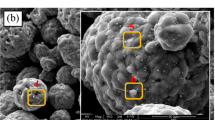Abstract
Despite of the permanent progress of technique and finding of the new, modern materials that successfully replace metals, steel continues to play an important role in the technical practice. The tendency is to discover the new alloys with better mechanical and technological characteristics, compared to conventional and standard types of steels. High-alloyed Cr–Mo steel, with a high content of Vanadium is the new type of wear resistant material, with high hardness and satisfactory impact and fracture toughness. During the solidification process Vanadium, as a strong carbide forming element, creates a network of M7C3 type carbide grains around the metal matrix, while in the matrix, the finely dispersed V6C5 type carbides are formed. In this paper, the chemical composition and morphology have been studied of carbides and the other phases present in the metal matrix in 1.4 wt % C, 12 wt % Cr, 1.0 wt % Mo steels with additions up to 3.0 wt % V. Experimental results indicate that Vanadium affects the solidification process in high Chromium steel. Vanadium is distributed between eutectic M7C3 carbide and the matrix, but its content in carbides is considerably higher. Vanadium changed the microstructure parameters of phases present in the structure of alloys, including volume fraction, size and morphology.
Similar content being viewed by others
References
T. N. Baker, Mater. Sci. Technol. 25 (9), 1083 (2009).
M. Filipovic, E. Romhanji, and Z. Kamberovic, ISIJ Int. 52 (12), 2200 (2012).
A. Todic, D. Cikara, T. Todic, et al., Mater. Manuf. Processes 27, 1193 (2012).
M. Filipovic, Ž. Kamberovic, and M. Korac, J. Metall. 11 (4), 345 (2005).
C. Capdevila, C. Garcia-Mateo, J. Chao, and F. G. Caballero, Mater. Sci. Technol. 25 (11), 1383 (2009).
D. Cikara, S. Markovic, and D. Cikara, Metalurgija 1 (7), 41 (2001).
M. Radulovic, M. Fiest, and K. Peev, Mater. Sci. Technol. 10 (12), 1057 (1994).
F. William, Mechanical Behavior of Materials (Cambridge Univ. Press, New York, 2005).
Z. Wang, D. He, C. Yu, and J. Jiang, Hanjie Xuebao Trans. China Weld. Inst. 31 (9), 61 (2010).
Y. Lin, C.-C. Lin, T.-H. Tsai, and H.-J. Lai, Mater. Manuf. Processes 25 (4), 246 (2010).
M. Filipovic, Z. Kamberovic, and M. Korac, Mater. Trans. 52 (3), 386 (2011).
Author information
Authors and Affiliations
Corresponding author
Additional information
The article is published in the original.
Rights and permissions
About this article
Cite this article
Todić, A., Pejović, B., Todić, T. et al. The Effect of Vanadium on Morphology and Chemical Composition of Carbides in High Alloyed Chromium–Molybdenum Steels. Crystallogr. Rep. 62, 1028–1034 (2017). https://doi.org/10.1134/S1063774517070288
Received:
Published:
Issue Date:
DOI: https://doi.org/10.1134/S1063774517070288




